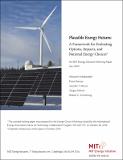Plausible Energy Futures: A Framework for Evaluating Options, Impacts, and National Energy Choices.
Author(s)
Arbabzadeh, Maryam; Gençer, Emre; Morris, Jennifer F.; Paltsev, Sergey; Armstrong, Robert C.
DownloadWorking paper: Plausible Energy Futures (3.274Mb)
Metadata
Show full item recordAbstract
The global energy system is undergoing major transformations. The world faces a dual challenge of meeting increasing energy demand while reducing greenhouse gas emissions. This change is characterized by the convergence of power, transportation, industrial, and building sectors, and the surge of multi-sectoral integration. Such transformation of energy systems requires a combination of technology selection and policy choices to ensure providing reliable and clean energy. Understanding the implications of these dynamics is challenging and requires a holistic approach to provide systems level insights.
In this working paper, we provide an overview of energy transformation analysis and projection tools and discuss the use of quantitative methods to examine possible future energy pathways. This is done to facilitate achieving decarbonization goals by providing thought leaders and policy makers with a robust framework in which energy choices and decarbonization goals can be made based on lifecycle analyses. We synthetize our findings applicable to modeling tools based on discussions with colleagues in other academic institutions and government labs and provide a summary of a wide range of lifecycle assessment (LCA) and energy modeling tools.
Our assessment shows that although there is considerable related research work emerging, there is a lack of readily available or generally accepted quantitative models and tools that consider a broad and robust lifecycle analysis approach for a range of plausible energy futures at regional and national levels. Such a tool is needed to help policy makers, industry, investors, and the financial sector to better understand and make decisions on energy choices and energy transitions, and avoid narrowly framed and advocacy-driven pathways.
We at MIT have substantial experience in building and maintaining energy system assessment tools:
i) A comprehensive system-level and pathway-level lifecycle assessment model, which is called the Sustainable Energy Systems Analysis Modeling Environment (SESAME). SESAME is a publicly available, open access model with multi-sector representation.
ii) The Integrated Global System Modeling framework (IGSM), which combines an economy-wide, multi-sector, multi-region computable general equilibrium (CGE) model (The MIT Economic Projection and Policy Analysis model, EPPA) with a natural systems component (The MIT Earth System model, MESM). The IGSM is an integrated assessment model (IAM).
To quantify additional environmental impact categories such as air pollutants and water footprint, we develop an expanded SESAME platform. For an economy-wide scenario analysis, we use the MITEI Energy Choice Program Working Paper 3 modeling results from our EPPA model. The expanded SESAME version will be a publicly available technology options and scenario analysis tool that can use input information from any economy-wide system (or use the default settings that represent our base-case values). The tool will evaluate options, impacts, and national energy choices for exploring the impacts of relevant technological, operational, temporal, and geospatial characteristics of the evolving energy system. It focuses on lifecycle analysis with high technology resolution (linked with the existing MIT energy-economic models) that provides economic information and quantifies lifecycle GHG emissions, as well as impacts related to criteria pollutants and water. Such analysis highlights how effective policy choices and technology selection can reduce such environmental impacts
Date issued
2019-10-30Department
MIT Energy InitiativePublisher
MIT Energy Initiative
Keywords
energy, energy futures